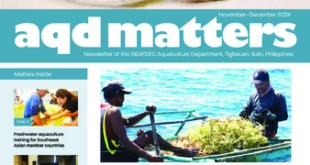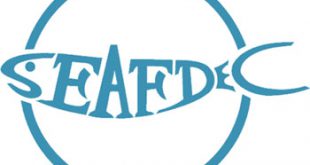
Welcome to FishWorld!
 SEAFDEC FishWorld is a museum-aquarium and visitor center dedicated to science and environment education for the general public particularly about aquatic ecosystems and biodiversity, aquaculture, fisheries, and the aquatic sciences. FishWorld opened to the public on 7 July 2000 and has since received about 10,000 visitors a year.
SEAFDEC FishWorld is a museum-aquarium and visitor center dedicated to science and environment education for the general public particularly about aquatic ecosystems and biodiversity, aquaculture, fisheries, and the aquatic sciences. FishWorld opened to the public on 7 July 2000 and has since received about 10,000 visitors a year.
FishWorld offers a 30-min regular tour – a 10-min briefing or institutional video and 20 min to examine the poster exhibits, aquarium animals, and the museum collections. A self-guided tour of FishWorld is encouraged.
The SEAFDEC hatcheries and research laboratories may be visited at pre-arranged times by groups with special needs. This tour takes about 1hr for a group of 30 persons.
 Platon Hall
Platon Hall
The front reception hall honors AQD Chief Dr. Rolando R. Platon (1996-2006) who allocated funds to build FishWorld in 1999. The mural Reef Rangers decorates the hall.
AQD Milestones
Mounted plaques identify the main events in SEAFDEC/AQD research, technology generation, and training for breeding, seed production, and growout of milkfish, tiger shrimp, rabbitfish, grouper, catfish, Nile tilapia, and mud crab.
Ticket Office
Here visitors meet the FishWorld Guide, set appointments, and pay the entrance fees.
SeaStore
Sold here are SEAFDEC/AQD publications, Tshirts, and sea souvenirs including dry specimens of marine animals labeled with scientific names.
Kids’ Activity Center
Held here are drawing contests, workshops, and laboratory sessions.
Aquaculture Hall
Posters explain the biology and farming of several aquatic species in southeast Asia.
Invertebrates Collection
Exhibited in all-glass cabinets are dry specimens more than 4,000 species of mollusks, crustaceans, corals, echinoderms, and sponges from around the Philippines and elsewhere. These reference collections are used by scientists, teachers, and students.
Audio-Visual Room
A 50-seat hall is available for video-briefing, lectures, meetings, and contests. Paintings of high school students fill the walls— output from the various contests at FishWorld.
Rabanal Fish Tableau
A freshwater pond holds carps, tilapia, pacu, guppies, and several tortoises. Dr. Herminio Rabanal, a pioneer in Philippine aquaculture, paid for the concrete fish sculpture which was painted into the Fish Tableau (2010).
 Toledo Hall
Toledo Hall
The back reception hall honors AQD Chief Dr. Joebert D. Toledo for supporting FishWorld. The hall is bounded by the murals, Sinabawan (2006) and Mandala Marina (2007). A corner tank holds the carcass of a megamouth shark.
Curator’s Office and Lab
Dr. Teodora Bagarinao offers internships and mentoring in biodiversity research. A glass case exhibit nearby shows that biodiversity is essential to human life.
Fish Collection
Here are alcohol-preserved specimens of fishes and crustaceans from the Philippines.
Fisheries Hall
Posters show the commercial species harvested by fisheries in the Philippines, the importance of sea food, and the problem of overfishing. In cabinets are dry-mounted fishes and some reptiles, and from the rafters hang a sunfish, an Irrawaddy dolphin, a false killer whale, and a Risso’s dolphin.
ASEAN-SEAFDEC Hall
A study room with an array of flags and posters on biodiversity from the SEAFDEC Member Countries. The seaweed herbarium and dry invertebrates in storage are also here.
Dagat Isda Gallery
The gallery shows paintings, sculptures, ceramics, glasscraft, and other artifacts that show the influence of fish and the ocean in human culture, tradition, and modern life.
Live Animal Exhibits
Three tables of aquaria show the fishes, crustaceans, mollusks, and echinoderms that SEAFDEC/AQD does research on, and many other species rescued from fishing operations at AQD stations.
Pawikan Rehab
Injured or sick sea turtles stranded onshore or captured by coastal fishing gears are brought to FishWorld for medical care and feeding before release back to sea.
Artist AnLeng painted all the murals at FishWorld.
FishWorld hoursMonday to Friday 8:00 am – 12:00 pm, 1:00 pm – 5:00 pm Weekends and holidays by appointment Entrance feesP25per person P15 per child up to 12 years Fees used for maintenance and operations. |
Appointments, more informationFishWorld Guide email fishworld@seafdec.org.ph Phone (63-33) 330 7032 or Ms. Hananiah Sollesta |
How to get to FishWorld
FishWorld is at the SEAFDEC Aquaculture Department in Tigbauan, southern Iloilo, about 25 km from Iloilo City. Turn right opposite the SEAFDEC main gate and FishWorld is up ahead to the left. Vehicles must drive left onto the side road to unload and park.
House rules
Please let us all ensure that FishWorld remains wholesome for all visitors.
- Clean footwear before entering FishWorld.
- No smoking inside FishWorld.
- No running around, no yelling.
- No food or drinks inside FishWorld.
- No littering in or around FishWorld.
- Do not touch the exhibits and specimens.
- Keep hands and faces off the glass walls.
- Use the toilets properly and keep them clean.
- Visitors may picnic under the trees or in the Visitors’ Pavilion at the backyard.
How to maximize the FishWorld tour
FishWorld is a science and environment education center. Learning is facilitated when enough time is allotted with the exhibits, and when the visiting groups are not so large (about 50 persons at one time).
- Visitors must obtain information about FishWorld before the trip. Get a copy of this leaflet and phone or email the FishWorld Guide or the Curator.
- Researchers, farmers, or college students who want to visit the research laboratories or consult SEAFDEC specialists must make appointments with the Research Division.
- Large groups of visitors, e.g., school children on field trips, must be scheduled in advance. Send a letter-request indicating name and address of visiting group, date and time of visit, number of children and adults, and aim of the visit.
- Group leaders must coordinate well with the FishWorld Guide, check out the exhibits in advance and determine what the students should learn during the tour.
- Students must be briefed about the FishWorld exhibits and given specific learning assignments.
- During the visit, big groups must split up into smaller groups. While one group watches the institutional video, another group can go around FishWorld.
- Older students (not children) may go on a tour of the hatcheries and laboratories, if so allowed on that particular day.
- Students could take a self-guided tour with this leaflet and ask questions of the FishWorld staff.
- Teachers should check the students’ learning assignments and give feedback.
Suggested learning assignments
- What is aquaculture, where and how is it done, and what are its products? How does aquaculture contribute to food security?
- What is fisheries, where and how is it done, and what are its products?
- What are the aquatic ecosystems in the Philippines? What plants and animals live in Philippine waters?
- How can we conserve and protect our aquatic ecosystems and biodiversity?
 SEAFDEC/AQD Southeast Asian Fisheries Development Center | Aquaculture Department
SEAFDEC/AQD Southeast Asian Fisheries Development Center | Aquaculture Department

